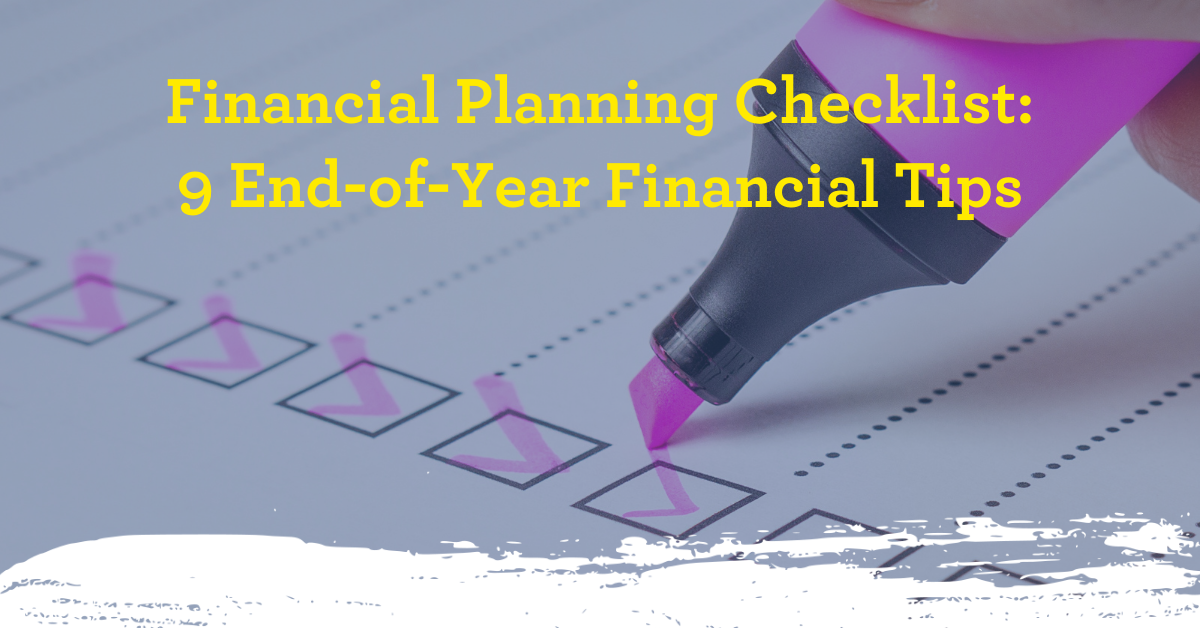As we get closer to the end of the calendar, it’s a natural time to work through a year-end financial planning checklist. Finances are often top of mind at this time anyway, with the holidays bringing increased spending on gifts and entertainment. Take some time before the ball drops to run through a year-end checklist — it can be the gift that keeps on giving.
Here are the nine things everyone should include in their end-of-year financial health checklist.
Year-End Financial Review Checklist
- Check the balance in your flexible spending account.
- Finalize your qualified retirement account contributions.
- Review your beneficiaries.
- Double-check your employer-sponsored benefits.
- Review any tax-deductible losses.
- Verify your tax withholdings are up to date.
- Make (and get receipts for) your final year-end charitable gifts.
- Review your savings goals.
- Check your credit report.
Now that you know what to check, let’s dig into each item in the year-end financial checklist to learn why they are important to review on a regular basis.
#1: Check the balance in your flexible spending account.
Many people forget (or perhaps never knew to begin with) that FSAs are typically “use it or lose it,” although the rules have temporarily changed due to the pandemic. Check with your employer to see what your specific situation is — you may benefit from a temporarily extended grace period allowing you to spend your unused FSA funds next year. If you have money that you can’t carry over into next year, make sure you spend the balance so that you don’t lose it.
#2: Finalize your qualified retirement account contributions.
Before the end of the year, make sure you add any final contributions to your retirement accounts. If you have a 401(k), keep the maximum contribution levels in mind. If you’re younger than 50, the contribution limit is $19,500, but if you are 50 or older, you qualify for “catch-up” contributions, meaning you can put up to $26,000 into your 401(k) each year.
Similarly, if you have a Roth IRA or a traditional IRA, you can contribute up to $6,000 (or $7,000 if you’re 50 or older) each year. Maxing out these tax-free or tax-deferred accounts is a great way to ensure your retirement planning is set up for financial success.
#3: Review your beneficiaries.
The end of the year is a natural time to take inventory of any changes you’ve experienced recently. If you’ve gone through some major life events (marriage, divorce, the birth or adoption of a child, death, etc.), you’ll want to make sure your named beneficiaries are up to date.
Even if you haven’t gone through a major change requiring a beneficiary to be added or removed, it is still worthwhile to make sure your primary beneficiary and contingent beneficiaries reflect your current wishes. Not all of your financial products and policies will be governed your will, so make sure you verify and update beneficiaries wherever you need to (your will, life insurance policies, 401(k), etc.).
#4: Double-check your employer-sponsored benefits.
Due to open enrollment periods, you may be required to review the benefits you receive through your employer around this time of year. If not, take some time to take stock of the benefits you are eligible to receive through your employer as part of your year-end you financial planning checklist.
Check with your employer to see if they offer a matching 401(k) contribution. If so, take full advantage of it to maximize your savings potential. Are there discount programs you are eligible to participate in? Can you add or increase a supplementary life insurance policy at group rates?
Additionally, make sure you know what the policy is on using up paid time off — if you have some vacation days you can’t roll over to the next calendar year, invest in yourself by taking some time off to recharge.
#5: Review any tax-deductible losses.
Have you incurred any tax-deductible investment losses this year? If so, you can record those tax losses and use them to offset any investment capital gains you may have had. And if you haven’t realized any capital gains during the tax year, you can still use those losses to offset your taxable income, lowering the amount you owe when paying taxes next spring.
The maximum deduction you can claim from capital losses is $3,000. If you have realized losses greater than that, keep track of it all. Realized losses don’t expire, and you can claim the remainder of your loss in future years.
#6: Verify your tax withholdings are up to date.
How might taxes have an impact on your financial plan? Review the tax withholdings coming out of your paycheck to double-check that you are not over- or underpaying your taxes. Much like with your beneficiary review, you’ll want to make sure that any major life changes are reflected in your W-4. Here are a few examples of events that may prompt you to update your withholdings.
- Job changes or taking on a second job
- Changes in your marital status
- Changes to your dependents
#7: Make (and get receipts for) your final year-end charitable gifts.
If you make charitable donations, collect donation receipts so you can claim them on your upcoming taxes. In addition to other itemizable expenses, such as health care or other medical expenses, mortgage interest or uninsured losses, charitable contributions can offset your tax liability.
You’ll need to add up all of your itemizable deductions to see if they are larger than the standard deduction, which varies based on your filing status. If you have significant qualified expenses and charitable gifts, you may come out ahead by itemizing. Make sure your year-end giving is complete by the end of the tax year in order to be eligible for deductions on next year’s tax return.
#8: Review your savings goals.
Do you have a savings plan or an emergency fund? If so, make sure that you are on track with your goals. Review what you are saving for (retirement, a specific purchase, education, etc.), and see if you’re financially on track to meet your goals.
If not, take the time to adjust your savings strategy — or adjust your goals and expectations. Maybe you need to put off that new car or vacation for another year, or maybe you realize you need to increase contributions to a 529 plan.
If you don’t have a savings plan, consider this your reminder to start one. Get in the habit of paying yourself first, in order to fund your future and any large, unexpected expenses that may arise.
#9: Check your credit report.
Although this is the final item in the year-end financial planning checklist, it might be the most important. How often should you check your credit score? The Consumer Financial Protection Bureau recommends checking your credit regularly to scan for errors and inaccuracies. With the frequency of digital data breaches, it’s wise to make sure you can verify the information present in your credit reports (credit cards, debts, etc.) and avoid being a victim of identity theft.
If you find errors in your reports, fixing them may lead to an improvement in your credit score. Additionally, reviewing your credit reports at least annually gives you a chance to verify any debts in your reports and make a plan to pay them down.
Work with your tax, legal and financial advisors to make sure you’re taking full advantage of these end of financial year tips. With this financial planning checklist, you can put yourself in great shape for next year and your overall financial goals.

